(You don’t need to be in Japan during a tournament to experience the thrill of sumo wrestling!)
Are you fascinated by the ancient art of sumo wrestling but can’t catch a tournament in Japan? Don’t worry! Visiting a morning sumo practice in Tokyo is a fantastic alternative, offering a unique and intimate look into the lives of these powerful athletes. I recently took a guided tour to experience it firsthand, and let me tell you, it was an unforgettable adventure!
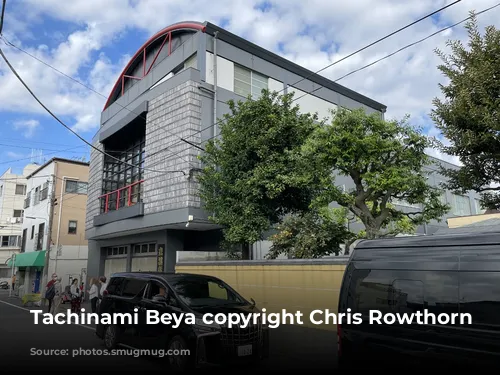
My Sumo Practice Experience: From Booking to Beya
I’d been to a few sumo tournaments (called “basho”) before, but a morning practice was entirely new to me. I booked a tour with Get Your Guide and chose a hotel in Tokyo’s Asakusa district to be near the meeting point, saving me an early morning commute. The booking process was a breeze, with clear communication and detailed instructions, including a map and photos of the meeting point.
On the day of the tour, I arrived promptly at 7:30am, ready for an exciting experience. Our guide, Yoko, welcomed us warmly and laid out the plan for the day. Joining me was a friendly Australian family, the only other participants on the tour. We boarded a local bus for the short journey to the sumo beya. Sumo beya (or heya) are training and living spaces for sumo wrestlers, many of which are located in the Ryogoku or Asakusa districts, close to the Kokugikan (Tokyo’s main sumo stadium).

A Sumo Primer and Our Beya: Tachinami Beya
As we traveled, Yoko provided us with an informative booklet on sumo, offering a concise history and explanation of the sport. The Australian children, particularly excited to see the wrestlers up close, peppered Yoko with questions. After a quick bus ride, we arrived at our destination: Tachinami Beya, a sumo beya known for producing several ozeki-level champions.
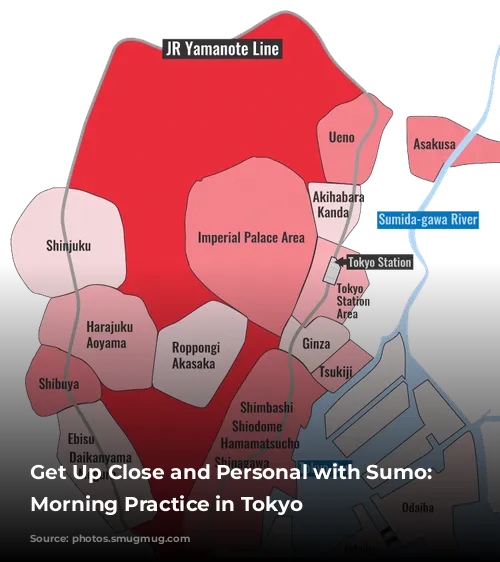
The Inner Workings of a Sumo Beya
We waited outside the beya for the doors to open. While we waited, a young man emerged, carrying recycling. Yoko explained that he was the most junior wrestler in the beya, responsible for household chores and dressing the hair of the senior wrestlers in the traditional chonmage hairstyle. At just 13 years old, he was already muscular and stocky, and I certainly wouldn’t want to get on his bad side!
The doors swung open, and we were ushered inside. A large viewing area awaited us, shared with another tour group. We sat on the floor, but chairs were provided for seniors or those with mobility issues. Yoko reminded us not to point our feet towards the dohyo (sumo ring), which is considered sacred.
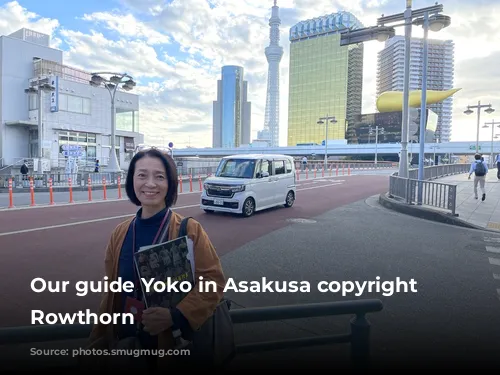
Warming Up to the Action: Sumo Stretching and Counting
A few sumo wrestlers entered from a side door. Without fanfare, they began their warm-up routine under the supervision of a senior wrestler. It was a slow and methodical process, with the wrestlers performing stretches and exercises. This part of the practice can be a bit tedious, but it’s a great opportunity to learn how to count in Japanese, as the wrestlers repeatedly count to ten in Japanese.
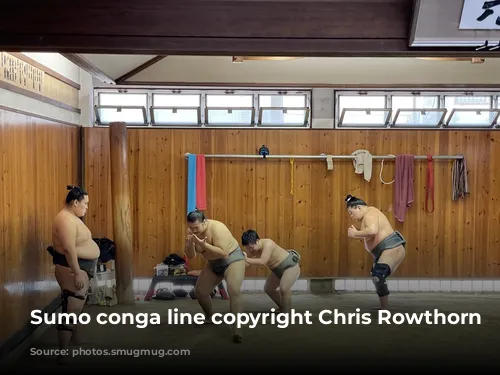
The Intensity Begins: Sumo Sparring in the Dohyo
Just as I started to get a little bored, the action kicked into high gear. The trainer directed two senior wrestlers into the dohyo. They assumed the tachi-ai position, ready to clash. At the trainer’s command, they collided with a thunderous impact, the sound reverberating through the room. It was an intense and visceral experience, even more so than the bouts I had witnessed at sumo tournaments, due to the intimacy of the surroundings.
These senior wrestlers sparred bout after bout, their bodies glistening with sweat and covered in sand from the dohyo. We witnessed throws, falls, and grips of all kinds. Sometimes, one wrestler would force the other out of the ring, while other times, a powerful body slam sent the opponent crashing to the ground with a resounding thud. It was difficult to hold back cheers or exclamations, a reaction that would have been perfectly acceptable at a sumo basho.
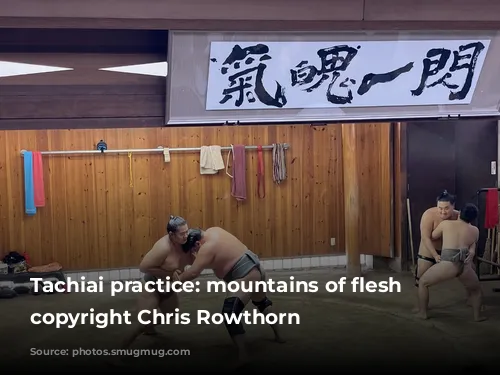
Light Relief: The Junior Wrestler Takes on a Senior
For a welcome change of pace, the young man we had seen earlier entered the dohyo. The trainer ordered him to spar with one of the senior wrestlers. I expected the wrestlers to be stoic and fierce, as is often the case with Japanese martial arts, but there was a lighthearted energy to this part of the practice. The senior wrestler went easy on the kid, who, in turn, gave his all. The trainer was smiling and joking as he coached the young wrestler, and the spectators, including myself, couldn’t help but laugh as the senior wrestler gently maneuvered the kid out of the ring. The kid put up a valiant fight, even managing to land some face slaps on his opponent.
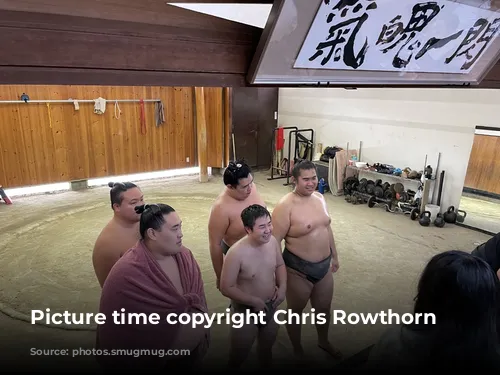
The Sumo Conga and Picture Time
After their sparring session, the wrestlers warmed down with a unique ritual we might call “the sumo conga,” where they walked around the dohyo, holding onto the mawashi (loincloth) of the wrestler in front of them.
Finally, it was time for photos. The wrestlers approached the viewing area and invited the crowd to take pictures with them. Everyone who wanted a picture had their chance. This is as close as you can get to actual sumo wrestlers without, well, wrestling them. It was surprising to see how down-to-earth and personable the wrestlers were, seemingly just as interested in the visitors as the visitors were in them.
Conclusion: An Intimate Glimpse into Sumo
Overall, visiting a morning sumo practice was a fascinating and exceptional close-up look at the world of sumo. I can’t believe I waited so long to experience it! If you’re a sumo enthusiast or just curious about this unique sport, I highly recommend booking a morning practice tour. You’ll gain a deeper appreciation for the discipline, dedication, and lighthearted side of sumo that you won’t find at a tournament.

